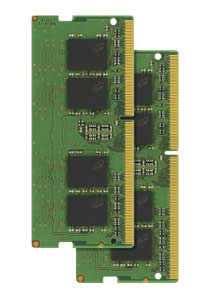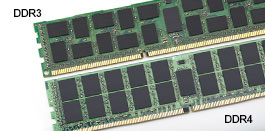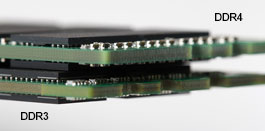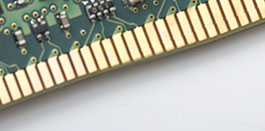DDR4 memory starts shipping for desktop machines and servers.
Through the years, the DDR Memory standard has been updated to DDR2, DDR3 and now DDR4 (JEDEC Satandard JESD79-4). It’s worthwhile to note that despite sharing the DDR name, each of these standards is unique, and they are mutually exclusive – a motherboard designed for DDR2 cannot take DDR3 for example. Also note that “GDDR5” is a variant of DDR3 that is designed for graphic card memory, and is not another generation of the DDR standard. (Currently there are no successors to DDR4 in the DDR standard under consideration, the next memory standard is likely to be a completely different signalling format, likely with a high speed serial, rather than parallel, interface.)
History: DDR (Double Data Rate) memory has been the standard for about fifteen years; as the PC133 SDRAM standard was being retired, there were two contenders for the next generation of higher performance RAM; DDR and RamBus (RDRAM). RAMBus at 533 – 1066 MHz was technically superior and faster, while DDR at its introductory speed of 400 MHz was the low-rent cousin. However the owners of the RAMBus patents made a fatal strategic error – they insisted on high licensing fees for their superior design, so motherboard manufacturers fled in droves to the lower performing but cheaper DDR design. Without the demand driven by motherboard and computer sales, RAMBus was relegated to a footnote in RAM history, and DDR memory took off, becoming faster as the technology was developed, and less expensive through massive economies in scale in production allowed by the near-universal adoption of the standard.
The advances with the DDR4 standard are:
- Higher module density (up to 128 GB per module as opposed to 16 GB for DDR3)
- Higher clock frequencies and therefore data transfer speeds (DDR4 2133 MHz to 3200 MHz vs. 800 MHz to 2400 MHz for DDR3).
- Lower voltages for the memory chips, DDR4 1.2V vs. between 1.35V and 1.65V for DDR3 (with a low voltage DDR4 standard to come at 1.o5V).
Running at lower voltage means less waste heat, as well as making it easier to design components with smaller circuitry. On the other hand, increased frequencies, lower voltages and smaller traces makes it more important for the designers to guard against electrical noise and crosstalk.
The first DDR4 modules to ship to the market in 2014 were ECC modules for Intel Xeon LGA 2011-v3 E5-1600 and E5-2600 series CPU-based servers and high end workstations, where their premium price can be justified by the increase in performance, and the higher densities may permit the opportunity for server motherboard makers to economise by installing fewer memory sockets, (four or eight instead of 12 or 16 sockets).
The Intel LGA 2011-v3 socket Core i7-5800 and i7-5900 series Haswell-ES processors and accompanying X99 motherboards are just coming to market as of this writing, and are the first desktop class machines to support DDR4.
The DDR4 DIMM package has some differences from DDR3.
- Although the modules are the same length, there are more connector pins (288 vs 240 pins) so consequently the connectors are narrower,
- the modules are a bit taller,
- the key in the connector edge is in a different position,
- the circuit boards are thicker (1.2mm vs. 1mm in DDR3) and
- there is a subtle curve to the connector edge to make inserting the module easier.
Photos courtesy Kingston Technology
 We will also see a DDR4 SODIMM package for laptops and compact desktops and servers, however machines to use them will not hit the market until late 2015
We will also see a DDR4 SODIMM package for laptops and compact desktops and servers, however machines to use them will not hit the market until late 2015
Photo courtesy Crucial
A note on Latency
The default CAS latency for DDR4-2133 is 15, compared with 9 0r 10 for DDR3-1600. These longer latencies eat up some of the performance gain of the increased MHz clock speed.
DDR3 at 1600 MHz, 9 cycles of CAS latency is 11.25 nanoseconds
DDR3 at 2133 MHz, 10 cycles of latency is 9.38 ns
DDR4 at 2133 MHz, 15 cycles of latency is 14.06 ns
so the latency of the DDR4 RAM does impose a relatively higher penalty.
However, this is offset by the faster bus speed and higher bandwidth, and also by the Haswell-E’s memory controller’s ability to do quad-channel access when you have four matching RAM modules. And the latency penalty will become progressively lower as both the speed of DDR4 modules increases and the yield of lower latency (CL13) modules increases.
Corsair has posted some benchmarks here www.corsair.com/en/blog/2014/september/ddr3_vs_ddr4_synthetic discussing the effect of latency on bandwidth.
A technical discussion of DDR4 including latency concepts is here frankdenneman.nl/2015/02/25/memory-deep-dive-ddr4/



